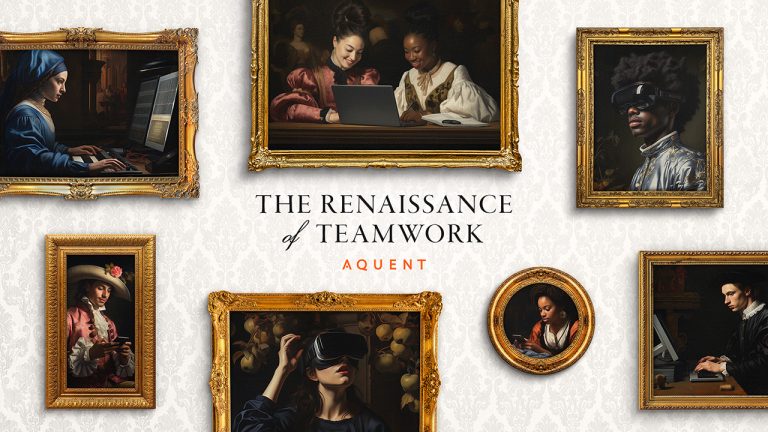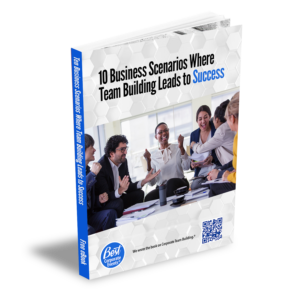Did you know that over 50% of high-performing teams say they “very effectively” respond to change and innovation—versus just 14% of teams that are low-to-moderately performing?
Or that members of high-performing teams are 40% more likely to say they have confidence in and can rely on their teammates? Or that high-performing teams are twice as likely to say they have very effective communication?
Those are among the findings in the recent report from global staffing agency Aquent, The Renaissance of Teamwork. This 36-page report is packed with insights on how to develop and maintain high-performing teams. Here are 10 insights that stood out to us.
Four Noteworthy Workplace Trends
When Heraclitus observed, in 535 BC, that “Change is the only constant,” he was discussing philosophy—but his wisdom applies just as well to the employment world of 2023. What’s fascinating is that three of the four big changes noted in the Aquent report are actually reversals of other very recent trends.
Here are Aquent’s four key trends, plus our thoughts:
-
Employers have more bargaining power
Per the report, employers are “dealing out layoffs and belt-tightening amid economic uncertainty.” But while the job market has cooled a bit, unemployment levels remain near historic lows. Whether this trend continues depends on whether we slip into recession next year or manage to conquer inflation with more of a soft landing.
-
Return-to-the-office ultimatums are rising
Employers increasingly want office workers back in the office, while employees accustomed to working remotely are resisting those demands. As written here recently in our post on how to resolve the return-to-the-office dilemma, it’s vital for employers to both make a compelling case for returning to in-person work and try to provide some level of flexibility for employees to determine when and where to work.
-
DEI programs are being scaled back
Aquent reports that companies “are curbing their (DEI) investments due to declining business results, as well as political and legal pushback.” We noted this risk in our recent post on unhappy employees. Most companies are likely to continue pursuing diversity, equity, and inclusion goals while adjusting their practices to adapt to the new legal and regulatory environment.
-
Technology continues to advance rapidly
More specifically, as the report notes, “Everyone is grappling with how to integrate generative artificial intelligence (AI) and understand what it means for jobs—now and in the future.” As AI use expands in workplaces, skills in human interaction (HI) will become even more valuable for employees.
Six Characteristics of High-Performing Teams
The Aquent report highlights eight behaviors that set the stage for high performance as well as additional findings about workplace AI, remote work, and diversity. Here’s a summary of six vital team characteristics, plus more of our thoughts and Aquent’s conclusions.
Per the report, high-performing teams:
-
Are adaptable to change
96% of high-performing teams say they are “moderately or very effective at adapting to change and embracing innovation,” versus just 73% of lower-performing teams.
Per Aquent, “High-performing teams have a much higher willingness to try new things, take risks, experiment, and learn from failure.”
One of the biggest drivers of change that employees and teams will need to adapt to over the next few years is AI. Per this study, members of high-performing teams are 58% more likely than those on lower-performing teams to rate the level of AI adoption on their team as good or excellent.
Workers on high-performing teams are also significantly more likely to say their team’s level of AI expertise is good or excellent, and that they are effective at leveraging AI to enhance productivity. And as the report authors note:
“As AI grows in importance, teams who are willing to embrace it are more likely to uncover a first-mover advantage by adapting to change more rapidly than their peers… The teams who are taking time to learn and practice using AI will be better prepared for the future.”
-
Are motivated by brand purpose
Members of high-performing teams are 24% more likely to say they are moderately or very motivated to contribute to fulfilling their company’s brand purpose.
Per the report, “A connection with company values and brand purpose motivates teams to outperform. Younger workers, particularly Millennials and those in Generation Z, want to work toward a purpose aligned with their beliefs, and this shapes their career decisions…Without knowing your company’s reason for being, it’s harder to feel motivated to dig deep or go the extra mile.”
One vital element of brand purpose in most companies is giving back to their local communities. As noted in our post on the value of corporate social responsibility (CSR) programs, other research has found that “More than 70% of employees say it’s imperative or very important to work in a company culture that is supportive of giving and volunteering, and 82% want opportunities to volunteer with peers in corporate-supported events.”
-
Have a high level of trust
94% of members of high-performing teams rate the level of trust among their teammates as good or excellent, compared to just two-thirds of lower-performing teams. Per the report:
“In high-performing teams, members know they can rely on each other…High-performing teams realize the synergies of collaboration and have leaders who foster trusting relationships via shared experience, communication, cooperation, and reliability.”
Strong leadership helps teams build confidence in each other, while bad leadership destroys trust. Team building programs help build trust by enhancing communication and workplace relationships. Leadership training can help employees at every level understand the importance of building trust and how to develop it.
-
Promote mental health and well-being
Asked to what extent their team cultivates a sense of psychological safety and mental well-being, members of high-performing teams were 47% more likely to say “somewhat” or “greatly.”
The key is to create an environment where team members feel they can openly exchange ideas, disagree (politely), admit mistakes, ask for help, and take risks. In such environments, the report notes, “Creativity and risk-taking excel, as well as strategic and diverse thinking, which are behaviors that drive complex problem-solving and breakthroughs.”
We’ve reported here previously that focusing on workplace relationships and employee well-being is vital for building high-performing teams. Team building and professional development programs play an important role in supporting the elements of workplace mental health and well-being.
-
Value diverse opinions
86% of members of high-performing teams say their colleagues actively seek diverse perspectives and opinions, compared to just 61% of lower-performing teams.
Per the report, “A range of opinions and perspectives can challenge assumptions and expose blind spots. Diversity, as well as a wide-ranging perspective, links directly to corporate performance.”
However, maximizing team cohesion when members bring different personalities and work styles can be challenging. The key to unlocking the high-performance potential of diverse teams is skilled leadership, trained in personality assessment, emotional intelligence (EQ), and both group and one-on-one communication.
-
Work flexibly
Members of remote/hybrid teams were 40% more likely to identify as high-performing than on-site teams. As the report authors write, “Fewer interruptions, better work-life balance, healthier habits, and the desire to continue a remote arrangement—all of these factors contribute to higher performance.”
The report further points out that, “Remote environments drive performance, not just through productivity but diversity too. They eliminate geographical, physical, and social barriers; improving career opportunities for working parents, caregivers, ethnically diverse employees, employees with disabilities, and other underrepresented groups.”
Team members in virtual/remote settings are more likely to say all members are comfortable expressing ideas; the team actively seeks diverse perspectives; and the team is effective at incorporating these ideas into the decision-making process.
There’s no question that employees are largely resisting mandates to return to the office full-time and that managers who insist on it risk losing talented workers. But other research has found that the formula isn’t as simple as remote good, on-site bad.
Numerous studies have found that what employees really value is flexibility, which is one of the most critical factors for increasing employee engagement. Ultimately, it’s not where employees work but how they work that matters.
How Team Building Fits In
Regardless of how the economy performs in the short term, the labor market is projected to remain tight for the foreseeable future. Team building, particularly CSR team building, increases employee loyalty, engagement, and job satisfaction. It builds strong relationships and effective communications among diverse team members, whether working remotely or in person.
Team building activities like Bridge to the Future, Momentum, and Pipeline help develop collaboration and problem-solving skills, as small teams assemble components that must mesh with the output of other teams to accomplish the overall objective.
Charitable CSR events add an element of brand purpose and giving back to the community. Programs like Build-a-Guitar®, Bike Build Donation®, and Kids Rock!™ are designed to help disadvantaged children and youth organizations, while other activities help the homeless (Donation Nation Care Packs), local food shelves (Mini-Golf Build and Food Donation), individuals with mobility issues (Build-a-Wheelchair®, Build-a-Rollator), or other groups.
As important as what these programs do, they are fun. Employees develop communication, collaboration, and problem-solving skills that increase their engagement level, productivity, and value to the organization in a way that doesn’t feel like work.
Creating Your High-Performance Workplace
The recently published Renaissance of Teamwork report from Aquent is loaded with insights on significant workplace trends and insights about the behaviors of high-performing teams.
Among the recommendations for creating a high-performance workplace environment are embracing innovation; articulating brand purpose; fostering trust; seeking and acting upon diverse perspectives; and providing employees with flexibility in their work arrangements.
Team building and professional development activities play a vital role in developing a culture of high performance, building trust, improving communication, promoting workplace mental health and well-being, helping diverse teams work together effectively, and other elements highlighted in Aquent’s research. Contact Best Corporate Events to take the next step in strengthening your team.


